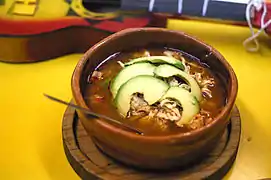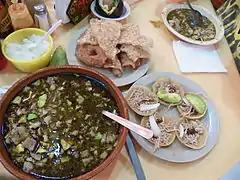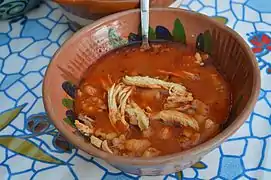Pozole
Pozole (Spanish pronunciation: [po'sole]; from Nahuatl languages: pozolli, meaning cacahuazintle, a variety of corn or maize) is a traditional soup or stew from Mexican cuisine. It is made from hominy with meat (typically chicken or pork), and can be seasoned and garnished with shredded lettuce or cabbage, chilli peppers, onion, garlic, radishes, avocado, salsa or limes. Known in Mesoamerica since the pre-Columbian era, the stew is common across Mexico and neighboring countries, served both as a day-to-day meal and as a festive dish.
_(cropped).jpg.webp) Pozole verde at a restaurant in Mexico City (2018) | |
| Type | Soup |
|---|---|
| Place of origin | Mexico |
| Region or state | Central Mexico |
| Created by | Nahuas |
| Serving temperature | Hot |
| Main ingredients | Hominy, meat (usually pork or chicken), chile peppers, seasonings |
| Variations | Blanco, Verde, Rojo |
Description
Pozole can be prepared in many ways, but all variations include a base of cooked hominy in broth. The broth is most commonly made with chicken or pork, but vegetarian preparations exist. When the broth is meat-based, pieces of the meat used to make the broth are usually served in the final dish; vegetarian versions substitute beans for the meat.
The three main types of pozole are blanco (white),[1] verde (green) and rojo (red). Pozole blanco—"white pozole"—is the preparation without any additional green or red sauce. Pozole verde—"green pozole"—adds a rich salsa verde based on green ingredients, possibly including tomatillos, epazote, cilantro, green chiles (typically jalapeños or serranos), or pepitas. Pozole rojo—"red pozole"—is similar, but using a salsa roja made from one or more dried or smoked red chiles, such as guajillo, piquin, or ancho, and usually tomato.
Pozole is commonly served accompanied by a wide variety of condiments. Common condiments include chopped onion, shredded cabbage, sliced radish, avocado, limes, oregano, tostadas, chicharrón, and chiles.[2]
Serving

Pozole is a typical dish in various states such as Nayarit, Sinaloa, Michoacán, Guerrero, Zacatecas, Jalisco, and Morelos. Pozole is served in Mexican restaurants worldwide. It is also popular (under the older spelling posole) in the cuisine of New Mexico where it was a common dish among the Pueblo Indians residing along the Rio Grande.[3][4]
Pozole is also a festive dish. In Mexico, pozole is typically served on New Year's Eve to celebrate the new year.[5][6] Pozole is frequently served as a celebratory dish throughout Mexico and in Mexican communities outside Mexico. Other occasions for serving pozole include Mexican Independence Day, birthdays, Christmas and other holidays.[7]
History

Pozole was mentioned in the 16th century Florentine Codex by Bernardino de Sahagún.[9] Since maize was a sacred plant for the Aztecs and other inhabitants of Mesoamerica, pozole was made to be consumed on special occasions.
According to research by the Instituto Nacional de Antropología e Historia (National Institute of Anthropology and History) and the Universidad Nacional Autónoma de México, on these special occasions, the meat used in the pozole may have been human. Possible archeological evidence of mass cannibalism may support this theory, though many other explanations for this evidence have been proposed, and no eyewitness accounts of Aztec cannibalism are known to exist.[8] Indigenous Nahua writings portray cannibalism as repugnant and abhorrent. Spanish writings included stories of wide-spread and religious cannibalism that were introduced "during post-Conquest religious conversion and Hispanicization.".[10] A paper has been published that suggests the Aztec people received necessary protein from native fauna such as fowl and reptiles as well as beans, which were prominent for the Aztecs.[11]
Gallery
 White pozole
White pozole.JPG.webp) Cooked hominy
Cooked hominy Dried hominy can be used for pozole, but it must be soaked and cooked.
Dried hominy can be used for pozole, but it must be soaked and cooked. Pozole topped with sliced avocado
Pozole topped with sliced avocado Green pozole, cooked in Guerrero State fashion
Green pozole, cooked in Guerrero State fashion Green pozole, with condiments, served in Zihuatanejo (Guerrero)
Green pozole, with condiments, served in Zihuatanejo (Guerrero) Red pozole, served in Mexico City
Red pozole, served in Mexico City A plate of condiments for pozole
A plate of condiments for pozole Red pozole, served in Oaxaca de Juárez
Red pozole, served in Oaxaca de Juárez
See also
- Fricasé
- List of maize dishes
- List of Mexican dishes
- List of soups
- List of stews
- Menudo (soup) – a similar dish made with tripe
- Mexican cuisine
References
- Cookpad: Pozole Blanco
- Bauer, Elise (8 October 2011). "Authentic Pozole Rojo (Red Posole) Recipe". Simply Recipes. Retrieved 13 May 2019.
- Cocking, Lauren (12 February 2017). "A Brief History of Pozole, Mexico's Take on Traditional Stew". Culture Trip. Retrieved 13 May 2019.
- Butel, Jane (11 December 1994). "Sacred Stew : Posole, a Native American corn dish, is served at pueblo festivals, but it can also be sampled in restaurants around Albuquerque". Los Angeles Times. Retrieved 13 May 2019.
- Anonymous; Seibert, Sandra; Anonymous; Pharo, Christine; Anonymous; Morethanbeefandtaters; Anonymous; G., Pauline; M., Monica (16 November 2016). "Posole Rojo". Food Network. Retrieved 13 May 2019.
- "Red Posole with Pork". Epicurious. 30 May 2017. Retrieved 13 May 2019.
- "Mexican Pozole". Mexico. Retrieved 13 May 2019.
- Pozolli. (n.d.). Nahuatl dictionary. Retrieved 28 August 2012, from http://whp.uoregon.edu/dictionaries/nahuatl/index.lasso
- Bernardino de Sahagún, Florentine Codex: General History of the Things of New Spain (Translation of and Introduction to Historia General de Las Cosas de La Nueva España; 12 Volumes in 13 Books ), trans. Charles E. Dibble and Arthur J. O Anderson (Salt Lake City: University of Utah Press, 1950–1982). Images are taken from Fray Bernardino de Sahagún, The Florentine Codex. Complete digital facsimile edition on 16 DVDs. Tempe, Arizona: Bilingual Press, 2009. Reproduced with permission from Arizona State University Hispanic Research Center.
- Isaac, Barry L. (2005). "AZTEC CANNIBALISM: Nahua versus Spanish and mestizo accounts in the Valley of Mexico". Ancient Mesoamerica. 16 (1): 1–10. doi:10.1017/S0956536105050030. ISSN 0956-5361. JSTOR 26309390. S2CID 162825038.
- Ortiz de Montellano, Bernard R. (12 May 1978). "Aztec Cannibalism: An Ecological Necessity?: The Aztec diet was adequate in protein and cannibalism would not have contributed greatly". Science. 200 (4342): 611–617. Bibcode:1978Sci...200..611O. doi:10.1126/science.200.4342.611. JSTOR 1746929. PMID 17812682. S2CID 35652641.




.jpg.webp)




_01.JPG.webp)